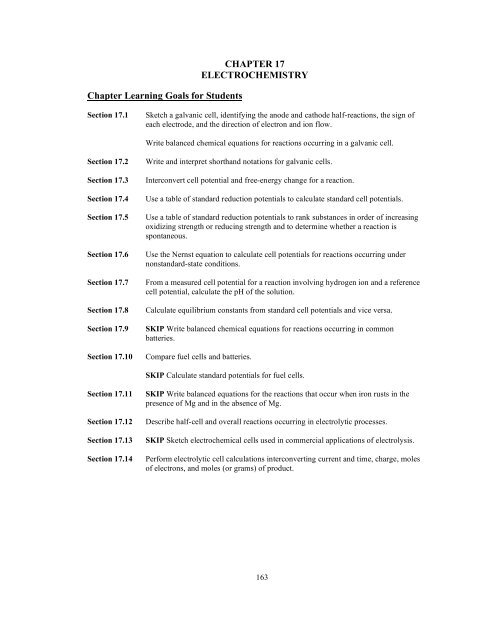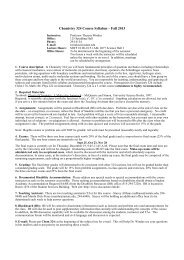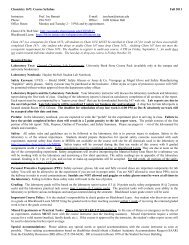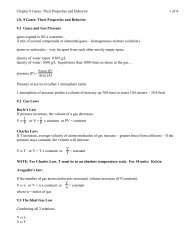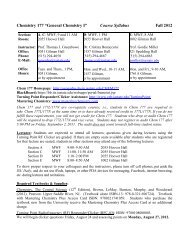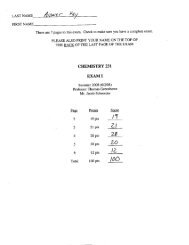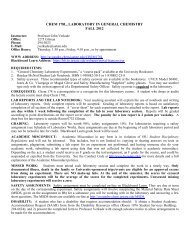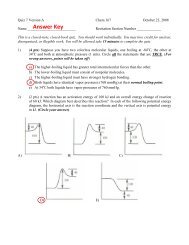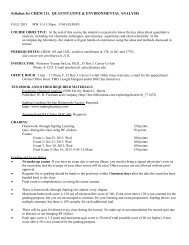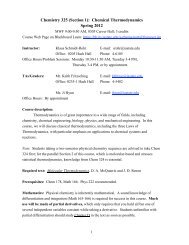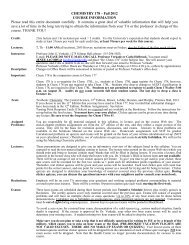CHAPTER 17 ELECTROCHEMISTRY Chapter Learning Goals for ...
CHAPTER 17 ELECTROCHEMISTRY Chapter Learning Goals for ...
CHAPTER 17 ELECTROCHEMISTRY Chapter Learning Goals for ...
You also want an ePaper? Increase the reach of your titles
YUMPU automatically turns print PDFs into web optimized ePapers that Google loves.
<strong>Chapter</strong> <strong>Learning</strong> <strong>Goals</strong> <strong>for</strong> Students<br />
<strong>CHAPTER</strong> <strong>17</strong><br />
<strong>ELECTROCHEMISTRY</strong><br />
Section <strong>17</strong>.1<br />
Sketch a galvanic cell, identifying the anode and cathode half-reactions, the sign of<br />
each electrode, and the direction of electron and ion flow.<br />
Write balanced chemical equations <strong>for</strong> reactions occurring in a galvanic cell.<br />
Section <strong>17</strong>.2<br />
Section <strong>17</strong>.3<br />
Section <strong>17</strong>.4<br />
Section <strong>17</strong>.5<br />
Section <strong>17</strong>.6<br />
Section <strong>17</strong>.7<br />
Section <strong>17</strong>.8<br />
Section <strong>17</strong>.9<br />
Section <strong>17</strong>.10<br />
Write and interpret shorthand notations <strong>for</strong> galvanic cells.<br />
Interconvert cell potential and free-energy change <strong>for</strong> a reaction.<br />
Use a table of standard reduction potentials to calculate standard cell potentials.<br />
Use a table of standard reduction potentials to rank substances in order of increasing<br />
oxidizing strength or reducing strength and to determine whether a reaction is<br />
spontaneous.<br />
Use the Nernst equation to calculate cell potentials <strong>for</strong> reactions occurring under<br />
nonstandard-state conditions.<br />
From a measured cell potential <strong>for</strong> a reaction involving hydrogen ion and a reference<br />
cell potential, calculate the pH of the solution.<br />
Calculate equilibrium constants from standard cell potentials and vice versa.<br />
SKIP Write balanced chemical equations <strong>for</strong> reactions occurring in common<br />
batteries.<br />
Compare fuel cells and batteries.<br />
SKIP Calculate standard potentials <strong>for</strong> fuel cells.<br />
Section <strong>17</strong>.11<br />
Section <strong>17</strong>.12<br />
Section <strong>17</strong>.13<br />
Section <strong>17</strong>.14<br />
SKIP Write balanced equations <strong>for</strong> the reactions that occur when iron rusts in the<br />
presence of Mg and in the absence of Mg.<br />
Describe half-cell and overall reactions occurring in electrolytic processes.<br />
SKIP Sketch electrochemical cells used in commercial applications of electrolysis.<br />
Per<strong>for</strong>m electrolytic cell calculations interconverting current and time, charge, moles<br />
of electrons, and moles (or grams) of product.<br />
163
<strong>Chapter</strong> <strong>17</strong>—Electrochemistry<br />
Lecture Outline<br />
<strong>17</strong>.1. Galvanic Cells 1<br />
A. Galvanic cell – a spontaneous chemical reaction generates an electric current<br />
B. Electrolytic cell – an electric current drives a nonspontaneous reaction<br />
C. Redox reaction<br />
1. Oxidation – a loss of electrons (an increase in oxidation number)<br />
2. Reduction – a gain of electrons (a decrease in oxidation number)<br />
3. Represent oxidation and reduction aspects of the reaction with half-reactions<br />
4. Oxidizing agent – species that causes oxidation to occur and is itself reduced<br />
5. Reducing agent – species that causes reduction to occur and is itself oxidized<br />
6. If a spontaneous reaction is carried out in a beaker:<br />
a. Oxidizing agent and reducing agent are in direct contact.<br />
b. Electrons are directly transferred.<br />
c. Enthalpy of reaction is lost to the surroundings <strong>for</strong> an exothermic reaction.<br />
7. If a spontaneous reaction is carried out in a galvanic cell – chemical energy released by the<br />
reaction is converted to electrical energy.<br />
D. For the reaction: Zn(s) + Cu 2+ (aq) → Zn 2+ (aq) + Cu(s)<br />
1. Use a Daniell cell, a type of galvanic cell, to carry out the reaction (textbook Figure 18.2).<br />
a. Consists of two half-cells<br />
i. A beaker with a strip of Zn in a solution of ZnSO 4<br />
ii. A beaker with a strip of Cu in a solution of CuSO 4<br />
b. Electrodes – strips of zinc and copper<br />
c. Salt bridge – a U-shaped tube that contains a gel permeated with a solution of an inert<br />
electrolyte<br />
2. The electrons can be transferred only through the wire.<br />
a. Oxidation and reduction half-reactions occur at separate electrodes.<br />
b. Electric current flows through the wire.<br />
3. Anode – the electrode at which oxidation takes place<br />
a. The negative (–) electrode<br />
b. Produces electrons<br />
4. Cathode – the electrode at which reduction takes place<br />
a. The positive (+) electrode<br />
b. Consumes electrons<br />
5. Anode and cathode half-reactions must add to give the overall cell reaction.<br />
6. Salt bridge maintains electrical neutrality by a flow of ions.<br />
a. Anions flow through the salt bridge from the cathode to the anode compartment.<br />
b. Cations migrate through the salt bridge from the anode to the cathode compartment.<br />
7. Electrons move through the external circuit from the anode to the cathode.<br />
<strong>17</strong>.2. Shorthand Notation <strong>for</strong> Galvanic Cells 2<br />
A. Single vertical line (|) represents a phase boundary.<br />
B. Double vertical line (||) represents a salt bridge.<br />
C. Shorthand <strong>for</strong> the anode half-cell is always written on the left of the salt-bridge symbol,<br />
followed on the right of the symbol by the shorthand <strong>for</strong> the cathode half-cell.<br />
1. Reactants in each half-cell are written first, followed by products.<br />
2. Electrons move through the external circuit from left to right.<br />
3. For Zn (s) + Cu 2+ (aq) → Zn 2+ (aq) + Cu(s):<br />
Zn(s) | Zn 2+ (aq) || Cu 2+ (aq) | Cu(s)<br />
D. Cell involving a gas<br />
1. Additional vertical line due to presence of additional phase<br />
1 Test Item File Questions: Multiple Choice 1-13, 101-106, 108-110, 112-115; Algorithmic 1-2; Short<br />
Answer 1<br />
2 Test Item File Questions: Multiple Choice 14-21, 107, 111, 116; Algorithmic 3-7; Short Answer 2<br />
164
<strong>Chapter</strong> <strong>17</strong>—Electrochemistry<br />
2. List the gas immediately adjacent to the appropriate electrode.<br />
E. Detailed notation includes ion concentrations and gas pressures.<br />
<strong>17</strong>.3. Cell Potentials and Free-Energy Changes <strong>for</strong> Cell Reactions 3<br />
A. Electromotive <strong>for</strong>ce (emf) – the driving <strong>for</strong>ce (electrical potential) that pushes the negatively<br />
charged electrons away from the anode and pulls them toward the cathode.<br />
1. Also called cell potential (E) or cell voltage<br />
2. Potential of a galvanic cell is a positive quantity.<br />
B. Coulomb (C) – amount of charge transferred when a current of 1 ampere (A) flows <strong>for</strong> 1 s.<br />
1 J = 1 C × 1 V<br />
C. Cell potential – measured with a voltmeter<br />
1. Gives a positive reading when the + and – terminals of the voltmeter are connected to<br />
cathode (+) and anode (–), respectively<br />
2. Can use voltmeter-cell connections to determine which electrode is the anode and which is<br />
the cathode<br />
D. Two driving <strong>for</strong>ces of a chemical reaction: cell potential, E and free-energy change, ΔG<br />
1. Related by ΔG = – nFE<br />
a. n = number of moles of electrons transferred in the reaction<br />
b. F (faraday) – the electrical charge on 1 mol of electrons<br />
c. 1 F = 96,500 C/mol e –<br />
2. ΔG and E have opposite signs.<br />
3. Spontaneous reaction has a positive cell potential but negative ΔG.<br />
E. Standard cell potential, E°– the cell potential when both reactants and products are in their<br />
standard states<br />
1. Solutes at 1 M concentration<br />
2. Gases at a partial pressure of 1 atm<br />
3. Solids and liquids in pure <strong>for</strong>m<br />
4. T = 25°C<br />
F. ΔG° = –nFE°<br />
<strong>17</strong>.4. Standard Reduction Potentials 4<br />
A. Standard cell potential is the sum of anode and cathode half-cell potentials.<br />
o<br />
E cell<br />
o<br />
= E anode<br />
o<br />
+ E cathode<br />
1. Potential of a single electrode not measurable<br />
2. Potential difference measured by placing a voltmeter between two electrodes<br />
3. Set of standard half-cell potentials developed<br />
a. Arbitrary standard half-cell chosen as reference point – assigned an arbitrary potential<br />
b. Potential of all other half-cells expressed relative to the reference half-cell<br />
B. Standard hydrogen electrode (S.H.E.) – reference half-cell<br />
1. Corresponding half-reaction – assigned an arbitrary potential of exactly 0 V<br />
2 H + (aq, 1 M) + 2 e – → H 2 (g, 1 atm) E o = 0.00 V<br />
2. Shorthand notation <strong>for</strong> S. H. E.<br />
H + (1 M) | H 2 (1 atm) | Pt(s)<br />
C. Standard potentials <strong>for</strong> half-cells determined by constructing a galvanic cell wth the half-cell of<br />
interest paired with the standard hydrogen electrode<br />
1. Standard oxidation potential – the corresponding half-cell potential <strong>for</strong> an oxidation halfreaction<br />
2. Standard reduction potential – the corresponding half-cell potential <strong>for</strong> a reduction halfreaction<br />
3.Whenever half-reaction is reversed, the sign of E o must be reversed.<br />
4. Standard oxidation potential and standard reduction potential always have the same<br />
magnitude but opposite signs.<br />
3 Test Item File Questions: Multiple Choice 22-28; Short Answer 3<br />
4 Test Item File Questions: Multiple Choice 29-34, 1<strong>17</strong>; Algorithmic 8; Short Answer 4<br />
165
<strong>Chapter</strong> <strong>17</strong>—Electrochemistry<br />
5. Table of standard reduction potentials – textbook Appendix D<br />
D. Conventions used in constructing a table of half-cell potentials<br />
1. Half-reactions written as reductions<br />
a. Oxidizing agents and electrons shown on reactant side<br />
b. Reducing agents shown on product side<br />
2. Half-cell potentials are standard reduction potentials, also known as standard electrode<br />
potentials.<br />
3. Half-reactions are listed in order of decreasing standard reduction potential.<br />
a. Strongest oxidizing agents are located in the upper left of the table.<br />
b. Strongest reducing agents are in the lower right of the table.<br />
4. Half-reaction ordering corresponds to ordering of oxidation reactions in the activity series.<br />
5. The more active metals at the top of the activity series have the more positive oxidation<br />
potential (more negative reduction potential).<br />
<strong>17</strong>.5. Using Standard Reduction Potentials 5<br />
A. Table of standard reduction potentials – summarizes much chemical in<strong>for</strong>mation<br />
1. Two or more oxidizing or reducing agents arranged in order of increasing strength<br />
2. Use to predict the spontaneity or nonspontaneity of thousands of redox reactions<br />
a. Combine half-reactions of interest and use<br />
o<br />
E cell<br />
o<br />
= E anode<br />
o<br />
+ E cathode<br />
b. May need to multiply half-reactions by some factor to ensure that electrons cancel<br />
c. Values of E° <strong>for</strong> the half-reactions not multiplied by that factor<br />
B. E° values independent of amount of reaction<br />
1. ΔG° = – nFE°<br />
2. ΔG° is an extensive property (depends on amount of substance).<br />
a. When amount of substance that reacts changes, ΔG° changes by the same amount as<br />
does n, the number of electrons transferred.<br />
b. But E° = – ΔG°/nF remains constant.<br />
C. Can predict reaction spontaneity by knowing the location of oxidizing and reducing agents in<br />
the table.<br />
1. An oxidizing agent can oxidize any reducing agent that lies below it in the table.<br />
2. E° <strong>for</strong> the overall reaction must be positive.<br />
<strong>17</strong>.6. Cell Potentials and Composition of the Reaction Mixture: The Nernst Equation 6<br />
A. Cell potentials depend on temperature and on the composition of the reaction mixture.<br />
1. ΔG = ΔG° + RT ln Q<br />
2. ΔG = – nFE; ΔG° = – nFE°<br />
3. – nFE = – nFE° + RT ln Q<br />
B. Nernst equation in volts at 25°C used to calculate cell potentials under nonstandard-state<br />
conditions<br />
E = E o ! 0.0592 log Q<br />
n<br />
<strong>17</strong>.7. Electrochemical Determination of pH 7<br />
A. Important application of Nernst equation<br />
1. Electrochemical determination of pH<br />
2. Measured by a pH meter<br />
B. Consider a cell with a hydrogen electrode anode and a second reference electrode cathode.<br />
1. Pt(s) | H 2 (1 atm) | H + (? M) || reference cathode<br />
2. E cell = 0.0592 pH + E ref<br />
3. pH is a linear function of the cell potential.<br />
5 Test Item File Questions: Multiple Choice 35-45; Algorithmic 9-12; Short Answer 5<br />
6 Test Item File Questions: Multiple Choice 46-56, 118-125; Algorithmic 13-15; Short Answer 6<br />
7 Test Item File Questions: Multiple Choice 57-62; Short Answer 7<br />
166
<strong>Chapter</strong> <strong>17</strong>—Electrochemistry<br />
pH = E cell ! E ref<br />
0.0592<br />
C. pH of a solution measured by measuring E cell<br />
D. Actual pH measurements use a glass electrode with a calomel electrode as the reference.<br />
<strong>17</strong>.8. Standard Cell Potentials and Equilibrium Constants 8<br />
A. Standard free-energy change <strong>for</strong> a reaction is related to both the standard cell potential and the<br />
equilibrium constant.<br />
1. ΔG° = – nFE°<br />
2. ΔG° = – RT ln K<br />
B. Combining the two equations:<br />
E o = RT<br />
nF<br />
ln K =<br />
2.303RT<br />
nF<br />
log K<br />
E o = 0.0592 log K<br />
n<br />
C. Most common use – calculating equilibrium constants from standard cell potentials<br />
D. Equilibrium constants <strong>for</strong> redox reactions tend to be either very large or very small in<br />
comparison with equilibrium constants <strong>for</strong> acid-base reactions.<br />
1. Positive value of E° corresponds to K > 1.<br />
2. Negative value of E° corresponds to K < 1.<br />
E. Three different ways to determine the value of an equilibrium constant K<br />
1. K from concentration data:<br />
K = [C]c [D] d<br />
[A] a [B] b<br />
2. K from thermochemical data:<br />
ln K = !"G o<br />
RT<br />
3. K from electrochemical data:<br />
ln K = nFE o<br />
RT<br />
<strong>17</strong>.9. Batteries 9<br />
A. Most important practical application of galvanic cells<br />
B. Battery features depend on application<br />
C. General features<br />
1. Compact and lightweight<br />
2. Physically rugged and inexpensive<br />
3. Provide a stable source of power <strong>for</strong> relatively long periods of time<br />
D. Lead storage battery<br />
1. Used as a reliable power source <strong>for</strong> starting automobiles <strong>for</strong> over 75 years<br />
2. 12 V battery – six 2 V cells connected in series<br />
3. Anode – series of grids packed with spongy lead<br />
4. Cathode – series of grids packed with lead dioxide, dipped into an aqueous solution of<br />
H 2 SO 4 (38% w/w)<br />
5. Electrode half-reactions and the overall cell reaction<br />
Anode: Pb(s) + HSO 4 – (aq) → PbSO 4 (s) + H + (aq) + 2 e –<br />
E° = 0.296 V<br />
Cathode: PbO 2 (s) + 3 H + (aq) + HSO 4 – (aq) + 2 e – → 2 PbSO 4 (s) + 2 H 2 O(l) E° = 1.628 V<br />
____________________________________________________________________________________________<br />
8 Test Item File Questions: Multiple Choice 63-67; Short Answer 8<br />
9 Test Item File Questions: Multiple Choice 68-76; Short Answer 9<br />
167
<strong>Chapter</strong> <strong>17</strong>—Electrochemistry<br />
Overall: Pb (s) + PbO 2 (s) + 2 H + (aq) + 2 HSO 4 – (aq) → 2 PbSO 4 (s) + 2 H 2 O(l)<br />
E° = 1.924 V<br />
6. PbSO 4 adheres to the surface of the electrodes.<br />
a. Recharge by using an external source of direct current to drive the cell reaction in the<br />
reverse, nonspontaneous direction<br />
E. Dry-cell batteries (Leclanché cells) – common household batteries<br />
1. Anode – Zn metal can<br />
2. Cathode – inert graphite rod surrounded by a paste of solid MnO 2 and carbon black<br />
3. Electrolyte – a moist paste of NH 4 Cl and ZnCl 2 in starch<br />
a. Surrounds the MnO 2 containing paste<br />
b. Acidic – causes corrosion of the Zn anode (Zn → Zn 2+ )<br />
4. Alkaline dry cell – modified version of Leclanché<br />
a. Replace NH 4 Cl (acidic) with NaOH or KOH<br />
b. Electrode reactions – oxidation of zinc and reduction of manganese dioxide<br />
i. Produces ZnO due to basic conditions<br />
ii. Zinc corrodes more slowly<br />
iii. Battery has a longer life<br />
c. Produces higher power and more stable current and voltage – more efficient ion<br />
transport in the alkaline electrolyte<br />
5. Mercury battery – used in watches, heart pacemakers, and other devices<br />
a. Small size<br />
b. Anode – Zn (same as dry cell)<br />
c. Cathode — steel in contact with HgO in an alkaline medium of KOH and Zn(OH) 2<br />
F. Nickel-cadmium batteries – used in calculators and portable power tools<br />
1. Rechargeable<br />
2. Anode – cadmium metal<br />
3. Cathode – NiO(OH) supported on nickel metal<br />
4. Solid products of electrode reaction adhere to the surface of the electrodes – allows battery<br />
to be recharged<br />
G. Nickel-metal hydride batteries – used in consumer electronic products and in hybrid gaselectric<br />
automobliles<br />
1. Less expensive than nickel-cadmium batteries<br />
2. Light weight<br />
3. Environmentally friendly<br />
4. Anode – metal alloy, LaNi 5<br />
5. Cathode – NiO(OH) supported on nickel metal<br />
H. Lithium-ion batteries – used in portable electronic products<br />
1. Li has a higher E o value <strong>for</strong> oxidation and lower atomic mass than any other metal.<br />
2. Anode – lithium metal or lithium atoms in a graphite electrode<br />
3. Cathode – metal oxide or metal sulfide that can incorporate Li +<br />
4. Electrolyte – lithium salt in an organic solvent<br />
5. Used in cell phones, laptop computers, and digital cameras, power tools, headlamps, hybrid<br />
electric cars<br />
<strong>17</strong>.10. Fuel Cells 10<br />
A. Fuel cell – a galvanic cell in which one of the reactants is a traditional fuel<br />
B. Reactants not self-contained within the cell – supplied from an external reservoir<br />
C. Hydrogen-oxygen fuel cell<br />
1. Best known<br />
2. Used in space vehicles as a source of electric power<br />
3. Porous carbon electrodes containing metallic catalysts<br />
4. Hot, aqueous KOH electrolyte<br />
5. Overall reaction<br />
10 Test Item File Questions: None<br />
168
<strong>Chapter</strong> <strong>17</strong>—Electrochemistry<br />
2 H 2 (g) + O 2 (g) → 2 H 2 O(l)<br />
D. Proton-exchange membrane (PEM) fuel cell<br />
1. Designed to power electric vehicles<br />
2. Similar to hydrogen-oxygen fuel cell, except KOH electrolyte replaced by a plastic<br />
membrane that conducts H + but not e –<br />
3. More environmentally friendly than the hydrogen–oxygen fuel cell<br />
E. Direct methanol fuel cell (DMFC)<br />
1. Similar to PEM fuel cell<br />
2. Uses aqueous CH 3 OH instead of gaseous H 2<br />
3. Lighter and higher energy density than conventional batteries<br />
4. Fuel is more readily available, safer, and easier to store than H 2<br />
<strong>17</strong>.11. Corrosion 11<br />
A. Corrosion – oxidative deterioration of a metal<br />
B. Well-known example of corrosion – conversion of iron to rust<br />
1. Requires both oxygen and water<br />
2. Involves pitting of the metal surface<br />
3. Rust is deposited at a location physically separated from the pits<br />
C. Proposed mechanism <strong>for</strong> <strong>for</strong>mation of rust – an electrochemical process in which iron is<br />
oxidized in one region of the surface and oxygen is reduced in another region<br />
1. Anode region: Fe(s) → Fe 2+ (aq) + 2 e – E° = 0.45 V<br />
2. Cathode region: O 2 (g) + 4 H + (aq) + 4 e – → 2 H 2 O(l) E° = 1.23 V<br />
3. Electrons flow from anode to cathode through the metal.<br />
4. Ions migrate through the water droplets.<br />
a. Fe 2+ reacts with O 2 and is oxidized to Fe 3+<br />
b. Fe 3+ reacts with H 2 O to <strong>for</strong>m Fe 2 O 3 ⋅ xH 2 O(s) (rust)<br />
5. Dissolved salt in water greatly increases electrolyte conductivity.<br />
6. Explains why cars rust more rapidly when road salt is used to melt snow and ice<br />
7. O 2 able to oxidize all metals except a few – O 2 /H 2 O half-reaction lies above the M n+ /M<br />
half-reaction<br />
D. Prevention of corrosion – shield the metal surface from oxygen and moisture<br />
1. Durable surface coating – metals such as chromium, tin, or zinc<br />
2. Galvanizing – coating by dipping into a bath of molten zinc<br />
3. Cathodic protection – protecting a metal from corrosion by connecting it to a second metal<br />
that is more easily oxidized<br />
<strong>17</strong>.12. Electrolysis and Electrolytic Cells 12<br />
A. Electrolytic cell – electric current used to drive a nonspontaneous reaction<br />
B. Processes occurring in galvanic and electrolytic cells are the reverse of each other.<br />
C. Electrolysis – the process of using an electric current to bring about chemical change<br />
D. Electrolytic cell<br />
1. Two electrodes in an electrolyte connected to a battery or some other source of direct<br />
electric current<br />
2. Battery – an electron pump, pushing electrons into one electrode and pulling them out of<br />
the other electrode<br />
3. Anode – electrode where oxidation takes place<br />
a. Positive sign<br />
b. Battery pulls electrons out of it<br />
4. Cathode – electrode where reduction takes place<br />
a. Negative sign<br />
b. Battery pushes electrons into it<br />
E. Electrolysis of molten NaCl<br />
1. Cathode – attracts Na +<br />
11 Test Item File Questions: Multiple Choice 77-81<br />
12 Test Item File Questions: Multiple Choice 82-88, 126-129<br />
169
<strong>Chapter</strong> <strong>17</strong>—Electrochemistry<br />
Na + + e – → Na(l)<br />
2. Anode – attracts Cl –<br />
2 Cl – → Cl 2 (g) + e –<br />
F. Electrolysis of aqueous NaCl<br />
1. Electrode reactions in an aqueous solution may differ from those <strong>for</strong> a molten salt.<br />
2. Cathode reaction can involve the reduction of Na + or the reduction of water.<br />
a. Reduction of water preferred – E o less negative <strong>for</strong> H 2 O than Na +<br />
b. 2 H 2 O(l) + 2 e – → H 2 (g) + 2 OH – (aq)<br />
3. Anode reaction can involve the oxidation of Cl – or the oxidation of water.<br />
a. Actual reaction – oxidation of Cl – due to overvoltage<br />
b. 2 Cl – (aq) → Cl 2 (g) + 2 e –<br />
4. Overvoltage – amount of voltage needed above the calculated standard reduction (or<br />
oxidation) potential <strong>for</strong> electrolysis to occur<br />
a. Needed when the half-reaction has a substantial barrier <strong>for</strong> electron transfer (slow rate)<br />
i. Surmounts barrier<br />
ii. Reaction proceeds at satisfactory rate.<br />
b. Small overvoltage needed <strong>for</strong> solution <strong>for</strong> deposition of metals<br />
c. Large overvoltage needed <strong>for</strong> <strong>for</strong>mation of O 2 or H 2<br />
d. Can’t predict – need experimental evidence if cell potentials are similar<br />
5. Overall cell reaction<br />
2 Cl – (aq) + 2 H 2 O(l) → Cl 2 (g) + 2 H 2 (g) + 2 OH – (aq)<br />
6. Na + is a spectator ion and reacts with the OH – to <strong>for</strong>m NaOH<br />
G. Electrolysis of water<br />
1. Electrolysis of any aqueous solution requires the presence of an electrolyte to carry the<br />
current in solution.<br />
2. If the ions of the electrolyte are less easily oxidized and reduced than water is, then water<br />
will react at both electrodes.<br />
3. Anode: 2 H 2 O(l) → O 2 (g) + 4 H + (aq) + 4 e –<br />
4. Cathode: 4 H 2 O(l) + 4 e – → 2 H 2 (g) + 4 OH – (aq)<br />
5. Overall cell reaction:<br />
2 H 2 O(l) → O 2 (g) + 2 H 2 (g)<br />
<strong>17</strong>.13. Commercial Applications of Electrolysis 13<br />
A. Manufacture of sodium<br />
1. Produced commercially in a Downs cell by electrolysis of a molten mixture of NaCl and<br />
CaCl 2<br />
2. Liquid Na produced at the cylindrical steel cathode is less dense than the molten salt and<br />
thus floats to the top part of the cell, where it is drawn off into a suitable container.<br />
B. Manufacture of chlorine and sodium hydroxide<br />
1. Electrolysis of aqueous NaCl<br />
2. Basis of chlor-alkali industry<br />
3. Anode and cathode electrolysis reactions of aqueous NaCl carried out in a membrane cell<br />
4. Membrane keeps Cl 2 and OH – apart but allows a current of Na + to flow.<br />
C. Manufacture of aluminum<br />
1. Hall–Heroult process<br />
2. Electrolysis of a molten mixture of Al 2 O 3 and cryolite (Na 3 AlF 6 ) at 1000 o C in a cell with<br />
graphite electrodes<br />
3. Success of process – use of cryolite as a solvent<br />
4. Electrode reactions involve the <strong>for</strong>mation of complex ions.<br />
a. Ions are reduced at the cathode to produce Al(l).<br />
b. Ions are oxidized at the anode to produce O 2 (g).<br />
i. O 2 (g) reacts with the graphite electrode to produce CO 2 (g)<br />
ii. Requires frequent replacement of the anodes<br />
13 Test Item File Questions: Multiple Choice 89-92<br />
<strong>17</strong>0
<strong>Chapter</strong> <strong>17</strong>—Electrochemistry<br />
5. Largest single consumer of electricity in the U.S.<br />
6. One mole of electrons produces only 9 g of Al.<br />
D. Electrorefining – purification of a metal by means of electrolysis<br />
E. Electroplating – coating of one metal on the surface of another using electrolysis<br />
1. Cathode – object to be plated (carefully cleaned)<br />
2. Electrolytic cell contains a solution of ions of the metal to be deposited.<br />
<strong>17</strong>.14. Quantitative Aspects of Electrolysis 14<br />
A. Amount of substance produced at an electrode by electrolysis depends on the quantity of charge<br />
passed through the cell.<br />
B. Follows directly from the stoichiometry of the reaction and the atomic mass of the product.<br />
C. Moles of electrons passed through a cell are determined from the electric current and the time<br />
that the current flows.<br />
Moles of e – 1 mol e–<br />
= charge (C) !<br />
96,500 C<br />
D. Sequence of conversion used to calculate the mass or volume of product produced by passing a<br />
known current <strong>for</strong> a fixed period of time.<br />
Current × time → Charge → Moles of e – → Moles of product → Grams of liters of product<br />
1. Current in amperes (A)<br />
2. Time in seconds (s)<br />
3. Charge in coulombs (C)<br />
E. Think of electrons as reactants in a balanced equation, and proceed as with any other<br />
stoichiometry problem.<br />
14 Test Item File Questions: Multiple Choice 93-98; Algorithmic 16-19; Short Answer 10<br />
<strong>17</strong>1
<strong>Chapter</strong> <strong>17</strong>—Electrochemistry<br />
<strong>CHAPTER</strong> <strong>17</strong><br />
<strong>ELECTROCHEMISTRY</strong><br />
Teaching Tips, Points of Emphasis, and Common Misconceptions<br />
Section <strong>17</strong>.1<br />
Section <strong>17</strong>.1<br />
Section <strong>17</strong>.3<br />
Section <strong>17</strong>.3<br />
Section <strong>17</strong>.3<br />
Section <strong>17</strong>.3<br />
Section <strong>17</strong>.4<br />
Section <strong>17</strong>.4<br />
Section <strong>17</strong>.5<br />
Section <strong>17</strong>.5<br />
Section <strong>17</strong>.6<br />
Anions flow through the salt bridge into the anode compartment while cations flow<br />
into the cathode compartment to maintain electroneutrality.<br />
The anode of a galvanic cell is negative (like an anion), and the cathode is positive<br />
(like a cation). Electrons move from the negative anode through an external circuit<br />
to the positive cathode.<br />
The driving <strong>for</strong>ce of a cell reaction, measured in volts and called cell voltage, cell<br />
potential, or electromotive <strong>for</strong>ce, is a function of the natural tendency of one<br />
substance to lose electrons and of a second substance to gain electrons. The greater<br />
these tendencies, the higher the cell voltage.<br />
When a chemical equation is balanced by the half-reaction method, the number of<br />
electrons that occur on both sides of the balanced equation (be<strong>for</strong>e canceling) is<br />
equal to the value of n.<br />
For a spontaneous reaction, ΔG is negative but E is positive.<br />
Standard conditions <strong>for</strong> E o , the standard cell potential, are identical with standard<br />
conditions <strong>for</strong> ΔG o , ΔH o , and ΔS o .<br />
Every reduction half-cell reaction has a corresponding standard reduction potential,<br />
E o red. If the reaction is reversed, it becomes an oxidation half-cell with a<br />
corresponding standard oxidation half-cell potential, E o ox. For any given half-cell<br />
reaction, E o ox = –E o red.<br />
The more positive the half-cell potential, the greater the tendency <strong>for</strong> the reaction to<br />
occur as written. The more negative the half-cell potential, the greater the tendency<br />
<strong>for</strong> the reverse reaction to occur.<br />
Half-cell potentials are never multiplied by a coefficient when used in the equation<br />
E o cell = E o ox + E o red.<br />
When predicting whether a reaction is spontaneous using Table <strong>17</strong>.1, some students<br />
find it useful to circle the two potential reactants and connect them with a line. If the<br />
line has a negative slope, the reaction is spontaneous; if the line has a positive slope,<br />
the reaction is nonspontaneous. If both potential reactants are on the same side of<br />
the arrows, no reaction can occur because an oxidation requires a simultaneous<br />
reduction.<br />
The general <strong>for</strong>m of the Nernst equation is used to correct the standard cell potential<br />
<strong>for</strong> concentrations other than 1 M, partial pressures other than 1 atm, or a<br />
temperature other than 25 o C. This <strong>for</strong>m of the Nernst equation applies only to<br />
reactions occurring at 25 o C.<br />
Section <strong>17</strong>.7 The Nernst equation relates the concentration of any chemical species, including H + ,<br />
to cell potential. This relationship is utilized in a pH meter which measures a cell<br />
potential and displays its value in terms of pH.<br />
<strong>17</strong>2
<strong>Chapter</strong> <strong>17</strong>—Electrochemistry<br />
Section <strong>17</strong>.8<br />
Section <strong>17</strong>.9<br />
Section <strong>17</strong>.10<br />
Section <strong>17</strong>.11<br />
Section <strong>17</strong>.11<br />
Section <strong>17</strong>.12<br />
Section <strong>17</strong>.12<br />
Section <strong>17</strong>.13<br />
The more positive the standard cell potential, the larger the value of the equilibrium<br />
constant, and the farther the equilibrium lies to the right.<br />
A multicell battery is comprised of galvanic cells wired in series, so the battery<br />
voltage equals the sum of the voltages of the individual cells.<br />
Although many metals react more readily than iron to <strong>for</strong>m oxides, their oxides<br />
provide a protective coating against further corrosion. The corrosion product of iron<br />
(“rust”) flakes off and exposes a fresh surface to further corrosion.<br />
In an electrolytic cell a constant input of energy from an external direct current (dc)<br />
source, such as a battery, is used to drive a nonspontaneous reaction. The voltage of<br />
the battery must be more positive than the absolute value of the voltage <strong>for</strong> the<br />
electrolysis reaction.<br />
Overvoltage is additional voltage that must be applied in excess of the calculated<br />
voltage to initiate an electrolytic reaction. It is most important <strong>for</strong> those systems<br />
involving gases that impede the flow of electrons between electrode surfaces and<br />
reactants in solution.<br />
This procedure and the Hall–Heroult process discussed below are examples of<br />
commercial uses of a colligative property (freezing point depression) to enable<br />
electrolytic reactions to be carried out more economically.<br />
Originally, chlorine was a useless byproduct of this process. The search <strong>for</strong> uses of<br />
chlorine resulted in many commercial chlorinated compounds, including plastic film<br />
used to wrap food.<br />
Stress the use of this flowchart along with the dimensional analysis method of<br />
problem solving.<br />
Overhead Transparencies<br />
Section <strong>17</strong>.1 T-<strong>17</strong>2 Figure <strong>17</strong>.1 Reaction of zinc metal with aqueous Cu 2+<br />
Section <strong>17</strong>.1 T-<strong>17</strong>3 Figure <strong>17</strong>.2a A Daniell cell<br />
Section <strong>17</strong>.4 T-<strong>17</strong>4 Figure <strong>17</strong>.4 A galvanic cell with Cu 2+ /Cu and standard hydrogen<br />
electrodes<br />
Section <strong>17</strong>.9 T-<strong>17</strong>5 Figure <strong>17</strong>.8 A lead storage battery<br />
Section <strong>17</strong>.10 T-<strong>17</strong>6 Figure <strong>17</strong>.11 A hydrogen–oxygen fuel cell<br />
Section <strong>17</strong>.11 T-<strong>17</strong>7 Figure <strong>17</strong>.12 An electrochemical mechanism <strong>for</strong> corrosion of iron<br />
Section <strong>17</strong>.11 T-<strong>17</strong>8 Figure <strong>17</strong>.13 Cathodic protection<br />
Section <strong>17</strong>.13 T-<strong>17</strong>9 Figure <strong>17</strong>.15 A Downs cell <strong>for</strong> production of sodium and chlorine<br />
Section <strong>17</strong>.13 T-180 Figure <strong>17</strong>.16 A membrane cell <strong>for</strong> production of chlorine and sodium<br />
hydroxide<br />
Section <strong>17</strong>.13 T-181 Figure <strong>17</strong>.<strong>17</strong> An electrolytic cell used in the Hall–Heroult process<br />
<strong>17</strong>3
<strong>Chapter</strong> <strong>17</strong>—Electrochemistry<br />
Section <strong>17</strong>.13 T-182 Figure <strong>17</strong>.18 Electrorefining of copper metal<br />
Section <strong>17</strong>.4 T-183 Table <strong>17</strong>.1 Standard reduction potentials at 25 °C<br />
Appendix F T-184 Concept map <strong>Chapter</strong> <strong>17</strong> Key Concept Summary<br />
Lecture/Laboratory Demonstration References<br />
Section <strong>17</strong>.1<br />
Section <strong>17</strong>.4<br />
Section <strong>17</strong>.11<br />
Section <strong>17</strong>.12<br />
Lee R. Summerlin, Christie L. Borg<strong>for</strong>d, and Julie B. Ealy, “Visible Oxidation-<br />
Reduction in Electrochemical Cells,” Chemical Demonstrations, A Sourcebook <strong>for</strong><br />
Teachers, Vol. 2 (American Chemical Society, Washington, DC, 1988), pp. 205-206.<br />
J. J. Fortman and R. Battino, “Determining the Metal Activity Series Using a Potato<br />
Porcupine,” J. Chem. Educ., Vol. 70, 1993, 939. Pieces of metal are inserted into a<br />
potato. A voltmeter is attached to a given metal and a copper reference electrode.<br />
With the potato serving as a salt bridge and source of electrolytes, the observed cell<br />
potentials are used to rank the metals in an activity series.<br />
Bassam Z. Shakhashiri, “Electrolytic Cells in Series: A Red, White, and Blue<br />
Electrolysis,” Chemical Demonstrations, A Handbook <strong>for</strong> Teachers of Chemistry,<br />
Vol. 4 (The University of Wisconsin Press, Madison, 1992) pp.<strong>17</strong>0-<strong>17</strong>3.<br />
Lee R. Summerlin, Christie L. Borg<strong>for</strong>d, and Julie B. Ealy, “Electroplating Copper,”<br />
Chemical Demonstrations, A Sourcebook <strong>for</strong> Teachers, Vol. 2 (American Chemical<br />
Society, Washington, DC, 1988), pp. 199-200.<br />
Literature References<br />
Section <strong>17</strong>.1 Ron DeLorenzo, “Electrochemical Errors,” J. Chem. Educ., Vol. 62, 1985, 424-425.<br />
Section <strong>17</strong>.1<br />
Section <strong>17</strong>.5<br />
Section <strong>17</strong>.9<br />
Section <strong>17</strong>.9<br />
Section <strong>17</strong>.10<br />
Penelope Ann Huddle, Margaret Dawn White, and Fiona Rogers, “Using a Teaching<br />
Model to Correct Known Misconceptions in Electrochemistry,” J. Chem. Educ., Vol.<br />
77, 2000, 104-110.<br />
Richard S. Treptow, “Dental Filling Discom<strong>for</strong>ts Illustrate Electrochemical<br />
Potentials of Metals,” J. Chem. Educ., Vol. 55, 1978, 189.<br />
Michael J. Smith and Colin A. Vincent, “Structure and Content of Some Primary<br />
Batteries,” J. Chem. Educ., Vol. 78, 2001, 519-521.<br />
Gerald Ondrey, Charlene Crabb, and Takeshi Kamiya, “Batteries: Full Speed<br />
Ahead,” Chem. Eng., Vol. 106 (2), 1999, 47-51.<br />
A. I. Onuchukwu, “Evaluation of Corrosion Susceptibility of a Metal: Student<br />
Corrosion Experiment II,” J. Chem. Educ., Vol. 65, 1988, 934.<br />
Media References<br />
Section <strong>17</strong>.1<br />
Section <strong>17</strong>.1<br />
Oxidation–Reduction Reactions Part 2 movie from Instructor’s Resource CD/DVD<br />
Voltaic Cells 1: The Copper–Zinc Cell movie from Instructor’s Resource CD/DVD<br />
<strong>17</strong>4
<strong>Chapter</strong> <strong>17</strong>—Electrochemistry<br />
Section <strong>17</strong>.2<br />
Section <strong>17</strong>.3<br />
Section <strong>17</strong>.4<br />
Section <strong>17</strong>.5<br />
Section <strong>17</strong>.6<br />
Section <strong>17</strong>.8<br />
Section <strong>17</strong>.11<br />
Section <strong>17</strong>.12<br />
Section <strong>17</strong>.13<br />
Shorthand Notation <strong>for</strong> Galvanic Cells activity from Instructor’s Resource CD/DVD<br />
Redox Chemistry of Iron and Copper movie from Instructor’s Resource CD/DVD<br />
Voltaic Cells II: The Zinc–Hydrogen Cell movie from Instructor’s Resource<br />
CD/DVD<br />
Standard Reduction Potentials movie from Instructor’s Resource CD/DVD<br />
Nernst Equation activity from Instructor’s Resource CD/DVD<br />
Equilibrium Constant activity from Instructor’s Resource CD/DVD<br />
Corrosion activity from Instructor’s Resource CD/DVD<br />
Electrolysis of Water movie from Instructor’s Resource CD/DVD<br />
Electroplating movie from Instructor’s Resource CD/DVD<br />
<strong>17</strong>5


